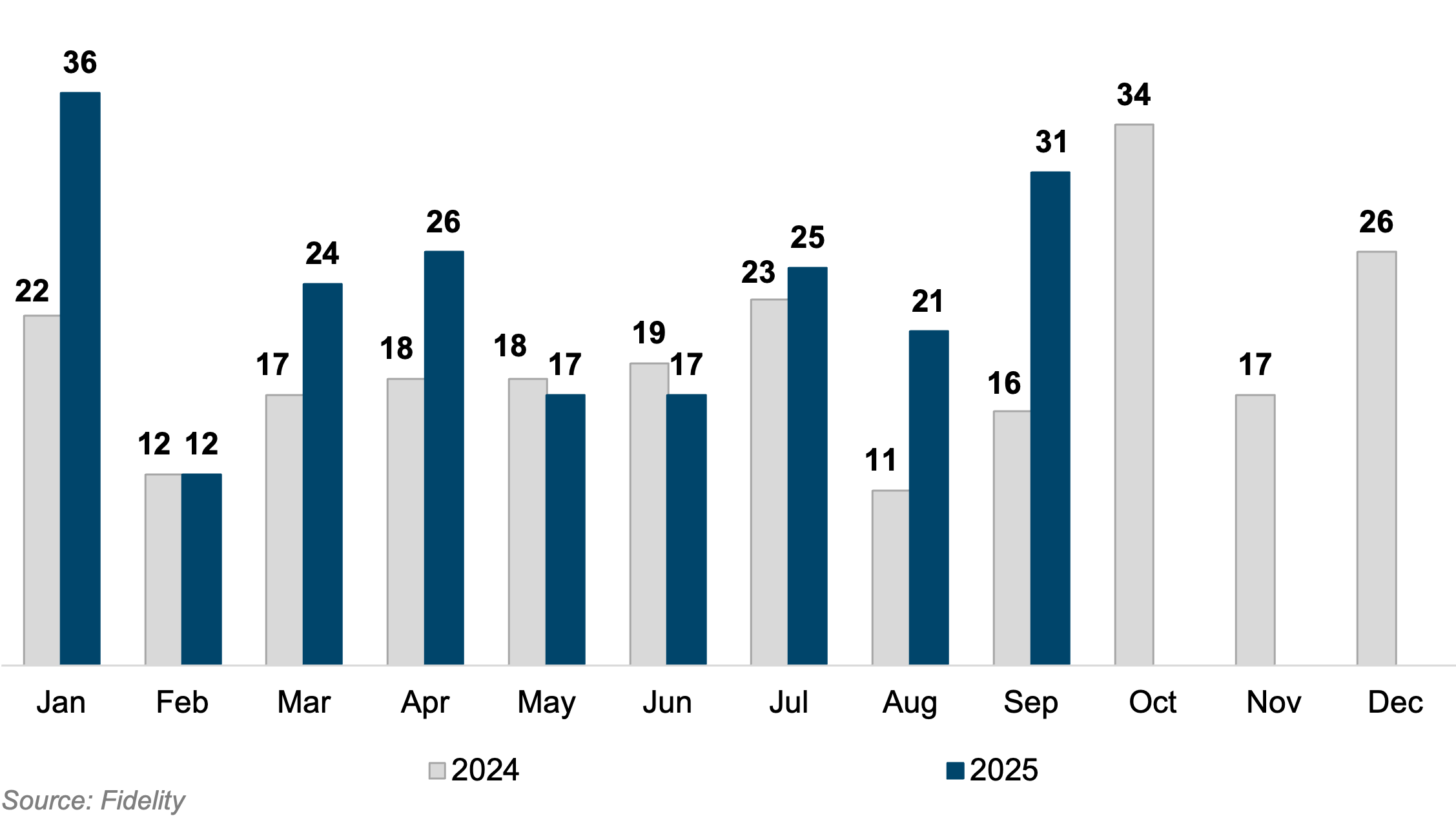RIA M&A Update: Q3 2025
Key Takeaways
-
RIA M&A activity reached record levels in 2025, with 209 transactions completed through September, surpassing 2024 totals and reflecting strong momentum in the wealth management industry.
-
Private equity firms and serial acquirers continued to drive deal activity, with private equity backing involved in 90% of September transactions and aggregators accounting for the majority of completed deals.
-
Favorable market conditions, including lower borrowing costs and recent Federal Reserve rate cuts, are expected to sustain elevated M&A activity as RIAs pursue consolidation, succession solutions, and growth opportunities.
M&A activity in the RIA industry, which had been trailing 2023 levels for much of 2024, experienced a surge in the first half of 2025. A spike in January set a new record for monthly deal volume, exceeding the high watermark previously set in October of 2024. Q1 2025 set a record for the number of transactions, which has since been superseded by Q3 2025 (72 vs 77 deals). Fidelity’s September 2025 Wealth Management M&A Transaction Report listed 209 deals through September, which exceeds the 156 deals executed during the same period in 2024.
Number of RIA M&A Transactions, 2024 vs. 2025

Deal activity in the investment management industry was robust compared to global M&A in the middle market and $1 billion+ segments, which both saw a decline in dollars transacted compared to the prior year, based on an EY analysis.
As of September 2025, total transacted AUM for the year reached $477.2 billion—a 12% decline from the same period in 2024. The average AUM per transaction during the first six months of 2025 was $2.3 billion, a 37% decline from the prior year. Notably, this decrease does not reflect LPL’s acquisition of Commonwealth, representing $285 billion AUM transacted, as we exclude independent broker-dealer transactions from our analysis. Including this transaction would imply a significantly higher total AUM transacted and average deal size compared to the same period in 2024.
RIAs partnering with private equity firms have contributed to the increase in deal size in recent years. According to Fidelity’s September 2025 Wealth Management M&A Transaction Report, private equity backing was involved in 90% of the M&A transactions reported in September.
The prevalence of serial acquirers and aggregators has continued in the RIA M&A market. In recent years, the professionalization of the buyer market and the entrance of outside capital have driven demand and increased competition for deals. Serial acquirers and aggregators have increasingly contributed to deal volume, supported by dedicated deal teams and access to capital. Such firms accounted for approximately 70% of transactions in Q3 2025 and about 28% of purchased assets.
Both buy-side and sell-side factors have fueled the surge in M&A among RIAs. Factors affecting deal activity include:
Willingness to Buy |
Willingness to Sell |
|---|---|
|
|
Deal activity has been supported by the supply side of the M&A equation, as the impetus to sell is often based on more than market timing. Sellers often look to solve succession issues, improve the quality of life, and access organic growth strategies. Such deal rationales are not sensitive to the market environment and will likely continue to fuel the M&A pipeline even during market downturns.
Another potential catalyst for M&A activity is the Federal Reserve’s decision to cut interest rates. The Fed implemented 100bps of rate cuts in Q4 2024 (and has cut further since). This marked a shift after two and a half years of rate increases, which contributed to a slowdown in deal volume during that period. With expectations of further rate cuts ahead, cheaper capital would likely encourage more deal activity in the RIA M&A market. As capital becomes more accessible and consolidation trends continue, the RIA market could experience renewed momentum.
What Does This Mean for Your RIA?
For RIAs planning to grow through strategic acquisitions: Pricing for RIAs has trended upwards in recent years, leaving you more exposed to underperformance. Structural developments in the industry and the proliferation of capital availability and acquirer models will likely continue to support higher multiples than the industry has seen in the past. That said, a long-term investment horizon is the greatest hedge against valuation risks. Short-term volatility aside, RIAs continue to be the ultimate growth and yield strategy for strategic buyers looking to grow their practice or investors capable of long-term holding periods. RIAs will likely continue to benefit from higher profitability and growth than their broker-dealer counterparts and other diversified financial institutions.
For RIAs considering internal transactions: We’re often engaged to address valuation issues in internal transaction scenarios, where valuation considerations are top of mind. Internal transactions don’t occur in a vacuum, and the same factors driving consolidation and M&A activity have also influenced valuations in internal transactions. As valuations have increased, financing in internal transactions has become a crucial secondary consideration where buyers (usually next-gen management) lack the ability or willingness to purchase a substantial portion of the business outright. As the RIA industry has grown, so too has the number of external capital providers who will finance internal transactions. A seller-financed note has traditionally been one of the primary ways to transition ownership to the next generation of owners (and, in some instances, may still be the best option). Still, increasing bank financing and other external capital options can provide selling partners with more immediate liquidity and potentially offer the next-gen cheaper financing costs.
For RIAs Considering Selling: Whatever the market conditions are when you go to sell, it is essential to have a clear vision of your firm, its value, and what kind of partner you want before you go to market. As the RIA industry has grown, a broad spectrum of buyer profiles has emerged to accommodate different seller motivations and allow for varying levels of autonomy post-transaction. A strategic buyer will likely be interested in acquiring a controlling position in your firm and integrating a significant portion of the business to create scale. At the other end of the spectrum, a sale to a patient capital provider can allow your firm to retain its independence and continue operating with minimal outside interference. Given the wide range of buyer models, picking the right buyer type to align with your goals and motivations is a critical decision that can significantly impact personal and career satisfaction after the transaction closes.
About Mercer Capital
We are a valuation firm that is organized according to industry specialization. Our Investment Management Team provides valuation, transaction, litigation, and consulting services to a client base consisting of asset managers, wealth managers, independent trust companies, broker-dealers, PE firms, alternative managers, and related investment consultancies.
 RIA Valuation Insights
RIA Valuation Insights 






